FESPA 2019 Key Takeaways
The last time I attended FESPA was in 2010, when it was also in Munich, a lovely city. Back then, FESPA occupied two halls, and I found this headline from one of the print trade magazines: “FESPA 2010 to be dominated by digital.”
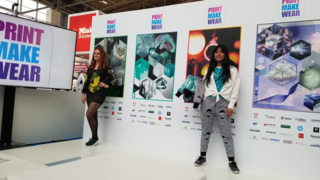
 The last time I attended FESPA was in 2010, when it was also in Munich, a lovely city. Back then, FESPA occupied two halls, and I found this headline from one of the print trade magazines: “FESPA 2010 to be Dominated by Digital.”
The last time I attended FESPA was in 2010, when it was also in Munich, a lovely city. Back then, FESPA occupied two halls, and I found this headline from one of the print trade magazines: “FESPA 2010 to be Dominated by Digital.”
Nine years later, and digital is still dominant, but we were surprised at how much analog technology there was. Screen printing was pretty prominent, as it should be, since the analog and digital technologies will co-exist for quite some time to come. We also saw hybrid analog/digital solutions, like the Digital Squeegee from M&R Digital. It was the first time I had actually seen it in action, and I was surprised at how large the inkjet portion of this machine was. Another similar hybrid solution from ROQ was also on display.
We also saw lots of embroidery machines. What was missing there, were at least two solutions for digital on-demand coloring of thread—Coloreel and Twine—that have the potential to dramatically change the embroidery landscape. They can feed one embroidery head with an unlimited number of colors, dyed to order based on the embroidery pattern. We’re interested to see the market reaction. Coloreel has already launched its product and snagged a partnership with thread company Coats. Twine launched its solution at the show. As with screen printing, however, we expect to see analog and digital solutions both playing a role for some time to come.
Digital printing of textiles for apparel and home décor played an expanded role as well, with one and a half halls dedicated to that, as well as two of the special features at the show that we covered in “Print. Make. Wear." The majority of the show floor, however, was dedicated to FESPA’s heritage, signs and display graphics, including vinyl print and wrap solutions.
Exhibitors seemed very happy with attendance and the quality of visitors. One MIS ERP company logged 1,600 visitors to its booth over the duration of the show—leads that will keep them busy for some time. Visitors were also buying…we ran into an American friend and print business owner who made several significant purchases for his business while also exploring many options for the future. He was certainly not alone.
A show like FESPA is also a great place to make new product announcements and/or unveil new products for the European market.
- Adobe introduced a new product, Adobe Textile Designer for Photoshop, an extension for Photoshop that is still in public beta. This solution adds significant new capabilities to Photoshop to make textile design easier. Watch for a video interview with Adobe’s Mike Scrutton explaining this new product. Adobe Textile Designer also played a key role in the "Print. Make. Wear." microfactory at the show.
- Dataline got a lot of attention with its MultiPress MIS/ERP software designed for sign and display graphics companies. However, according to Jef Stoeffels, the company’s marketing director, it can be used for just about any graphics business. Highlighted at the show were the MultiPress Installation App, which won an Innovation Award at a recent Sign & Print Fair in The Netherlands. This app helps mobile employees manage projects at the customer premises, including uploading photos. And the MultiPress Calculation Wizard makes complex price calculations simple. Integrated into an e-commerce site, it allows purchasers to request correct pricing online.
- Durst added two new printers to its P5 family of printing systems, the P5 350 (3.5 meters) and the P5 210 (2.1 meters), for wide-format printing. The company also highlighted its professional services offerings at the show, as well as new modular software solutions under the Durst Workflow, Durst Analytics and Durst Smart Shop umbrellas, offering automated production from “pixel to output.” This now becomes a more complete platform for large format operations.
- EFI showed a full range of printers for signs and display graphics, including the FabriVU 340i which incorporates printing and calendaring in one footprint. The company has placed more than 200 EFI FabriVU printers over the last two years. The EFI Pro 30f flatbed that can print on materials up to 4 inches thick and a larger print bed were also introduced. Software was highlighted in the EFI stand with a new version of its Optitex 2D/3D software with a new print-and-cut feature. There were plenty of samples of printed output on a wide variety of materials to attract visitors’ attention. At its press conference, company management answered questions about its proposed acquisition by Siris Capital and its recent acquisition of Turkish ink company BDR. The company also introduced EFI IQ Cloud Services, a new technology that reads data inside devices to provide actionable information to both owners and to allow EFI to better help customers optimize their printers and run jobs more efficiently.
- The HP Stitch series is HP’s first entry into the textile market. Two models were introduced earlier at the ISA show in Las Vegas. At FESPA, the company introduced its newest model, the 3.2-meter HP Stitch S1000 printing at up to 250 square meters per hour. Arguably, HP’s stand was one of the most colorful as the company decorated it with output from the Stitch family. From a workflow perspective, HP’s Print OS is also applicable to the Stitch line, and Stitch printers can print on either heat transfer paper or direct to fabric using HP’s proprietary inks. The printers have an embedded spectrophotometer for color quality control.
- Kornit had a significant presence at the show as well, with its new CEO, Ronen Samuel, announcing its goal to be a $500 million company by 2023. The main focus of the company is direct-to-garment (DTG), where it claims a market leadership position, but it also has direct-to-fabric solutions targeted at the interior décor market. Kornit’s primary announcement was the introduction of the Avalanche Poly Pro direct-to-garment printer with Kornit’s new NeoPoly technology for high-quality printing on polyester. The wet-on-wet printing process applies a fixation agent, then the image is printed, and finally a Poly enhancer is applied before the competed garment is dried in line with low-temperature curing of the ink. The inks are Oeko-Tex and Eco-Passport certified and do not contain PVCs or other toxic ingredients. The printer can produce up to 250,000 impressions per year.
- Massivit introduced a new 3D printer, the Massivit 1800 Pro, that offers a unique variable print resolution capability that allows changing of resolution level and layer thickness on the fly, increasing the range of items that can be created for visual communication, entertainment, concept prototyping and interior design applications. Because Massivit printed objects are hollow, and thus lighter weight than most 3D printed objects, they can be incorporated into 2D signage and display graphics to add a new dimensions to these projects.
- Mimaki engaged an interior designer, Claire Vos (watch our video interview with her, posted on WhatTheyThink.com), to talk about how Mimaki digital printing solutions have opened new opportunities for her as a designer. She participated in the press conference, and her designs were on display throughout the Mimaki booth. The company introduced several new products, including a flatbed printer with metallic UV inks, and the JFX200-2513 EX, which it called 2.5D, because of its ability to lay down 17 layers of clear ink for a textured appearance. Although layered printing is not new, Mimaki’s implementation only requires four simple steps for the operator to apply the feature. The company also added an entry-level 3D printer to its portfolio, with a selling price of €2,000.
- Roland DG showed the TrueVIS VG2, its 16th-generation print-and-cut solution for the sign and display graphics market, which has 40+ enhancements, including orange ink for a wider color gamut. The company also showcased the new VersaUV-LEF2-200 UV LED flatbed printer that includes premium finishing such as simulated embossing. For textiles, the Texart RT-640M textile sublimation printer for printing directly onto polyester fabrics or dye sublimation paper was on display. The LD-80 laser foil decorator for adding text, logos and graphics in a variety of metallic and holographic foils attracted a great deal of visitor attention as well.
These are just a few of the show highlights, since with more than 300 companies exhibiting, we don’t have space to cover them all.
FESPA Special Features Steal the Show
While all these announcements were exciting, we took particular note of the special educational features the show organizer highlighted this year.
Trends Theater
Throughout the show, content was presented in five important growth areas that can help attendees expand their businesses. These included décor, digital textile, signage, industrial and digital print for packaging. The Theater wrapped up with a print leaders panel discussion moderated by Frank Tückmantel, EFI’s vice president of corporate marketing (second from left). The panelists discussed their views of growth strategies for businesses in all segments of the market and included Daniel Sunderland, director of operations and finance at Serigráfica Industrial and Commercial in Mexico (far left); Bernhard Niemela, general manager and editor-in-chief at Deutscher Drucker Verlag (second from right); and Keith Ferrell, one of the founders of New Zealand’s Cactus Imaging (far right).
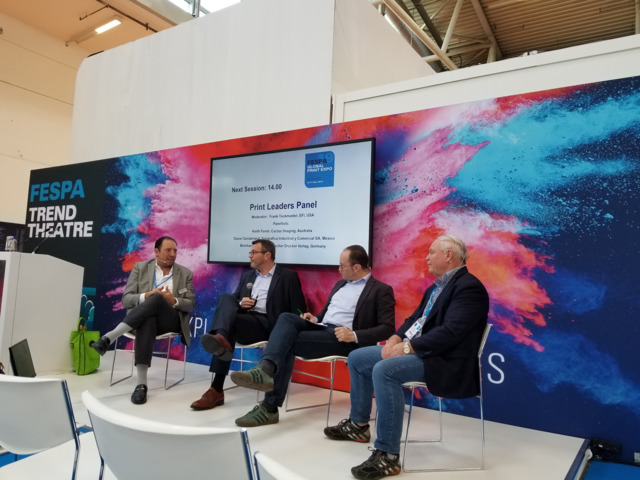
Much of the content for the Trend Theater was derived from a series of white papers produced by FESPA’s research partner, Smithers Pira, and provided insight into the issues and opportunities facing industry professionals today.
World Wrap Masters
This is a special feature that has been an attraction at FESPA for some years. Each day during the show, the world’s best wrappers – the vehicle type, not the singing type – compete to be crowned the World Wrap Master Champion. They are given a section of a vehicle to wrap within a limited amount of time, and judges evaluate their work to determine who gets to go to the next round. This year’s winner was Traian Moldovan, with Norman Brübachj coming in second. Free wrap workshops were offered every day at noon, as well. Most days, the area had plenty of show attendees watching the clock count down as wrappers worked to win a title spot.
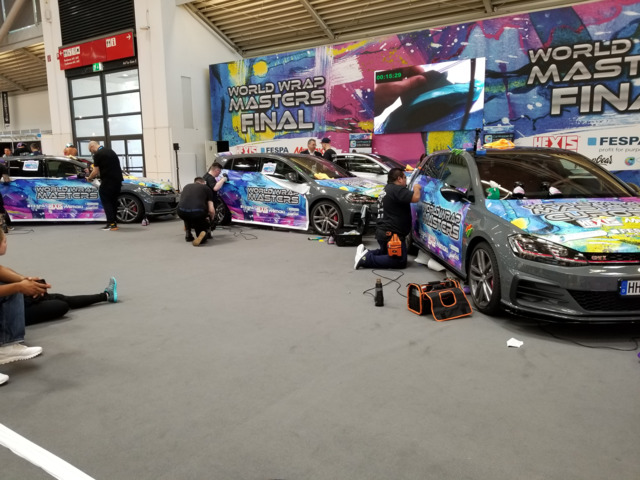
Printeriors
Located near the entrance of the fairgrounds, the Printeriors exhibit highlighted the benefits and opportunities of using print for interior décor. This included wallpapers, light boxes and soft furnishings such as curtains and cushions, tabletops and sideboards, window graphics and chairs. As an added benefit, the various Printeriors displays provided a place for visitors to rest their weary feet and to meet with colleagues and prospects while enjoying the beautiful décor. This year, the theme was “Inspired by Nature – Powered by Print,” and designs were coordinated by illustrator Jasper Goodall.
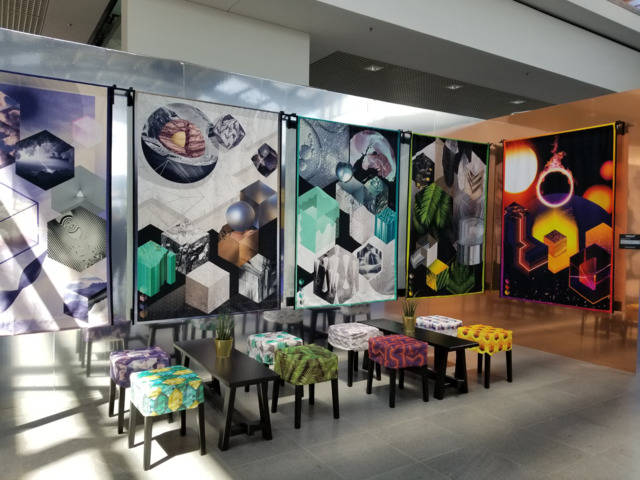
Colour L*A*B
This was a new feature at FESPA 2019 aimed at helping visitors improve color management in their own print businesses. Guided tours were hosted by Laurel Brunner of Digital Dots, and color management consultant Paul Sherfield. The tour took visitors through the entire process, from inks through color measurement of finished print. Here, HP’s Inkologist, Thom Brown, explains the importance of quality inks in the inkjet printing process to ensure the best possible color quality.
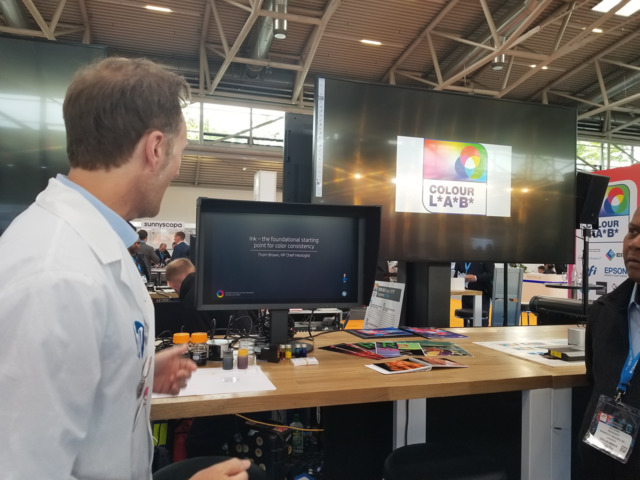
And here, Laurel Brunner answers questions from visitors about the use of color management hardware and software.
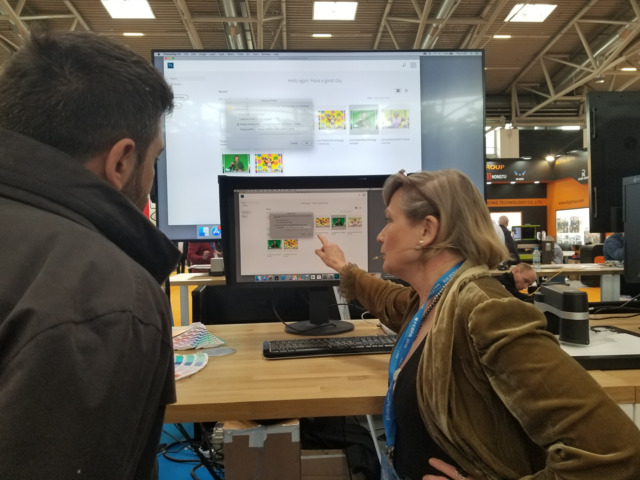
Print. Make. Wear.
Last but not least was my favorite, “Print. Make. Wear.” In its second year, this year’s interactive exhibit was much larger than last year. Microfactories on display included a large direct-to-garment printing operation that allowed visitors to take home a T-shirt they observed being manufactured on demand, from design through direct-to-garment print. It also featured a cut-and-sew area where operators created garments and home décor from digitally printed textiles designed by young designers.
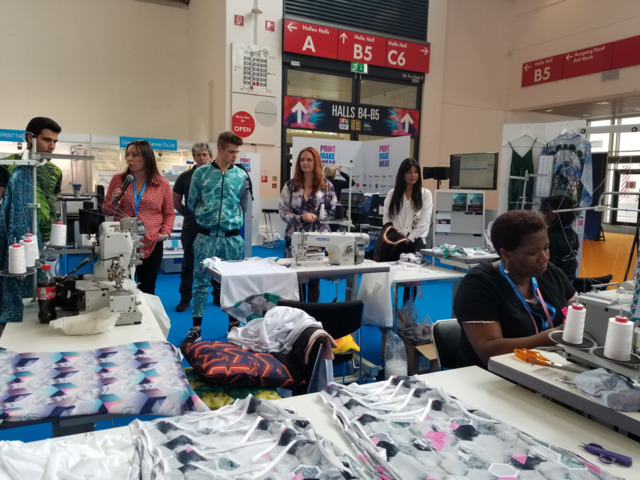
Tours were conducted by experts from the textiles and apparel industry, including Debbie McKeegan, textile evangelist for FESPA, who organizes the event. She’s pictured second from left, along with four of the young fashion designers who contributed their designs to the event. Be sure to watch the video interviews we did with her, one of which ran on May 29 on WhatTheyThink.com, and the other on June 11, where she explains what goes into putting the event together as well as how digital technologies are helping address sustainability issues in the textile industry.
Each day, the young fashion designers were able to show off their work in highly energetic fashion shows.

See You There Next Year?
FESPA 2019 was truly an amazing show, and well worth the trek across the pond. If you haven’t been to FESPA in Europe before, we highly recommend you put next year’s event on your calendar. We hope we’ll see you in Madrid for FESPA March 24-27, 2020.






